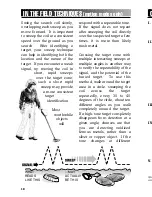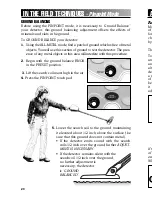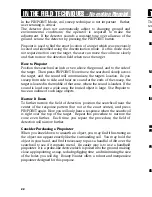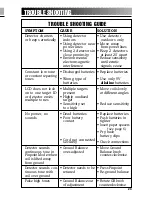
11
disappear, thus returning to detection the objects which fall into the
corresponding categories.
Discrimination Mode is a fixed-start-point elimination system. Objects
are cumulatively eliminated as the level of discrimination increases.
NOTCH MODE
To selectively eliminate a category from detection within the metallic spectrum,
use the NOTCH Mode.
Technical Note:
The NOTCH touch pad causes the status of an "R" segment to toggle
between ON and OFF.
To use the NOTCH Mode:
The NOTCH touch pad can be depressed at any time. But for
first-time use, place the detector in DISCRIMINATION mode.
A first demonstration is best accomplished as follows:
1) Turn the power OFF.
2) Turn the power ON.
3) Press DISC/A-M
4) Press NOTCH.
A flashing "R" will appear under the IRON-1 segment.
5) Press the DISCRIMINATION
▲
touch pad several times.
Notice that the "R" moves upon each press of the
DISCRIMINATION
▲
touch pad.
6) Press NOTCH again.
The flashing "R" will become permanently illuminated.
If an object has been “notched-out”, you can return it to detection status.
To “un-notch” a category:
1) Press NOTCH.
2) Move the flashing “R” over the permanently illuminated “R”, using
the DISCRIMINATION
▲
or
▼
touch pads.
3) Press NOTCH again.
After NOTCHING OUT a category the detector returns to the
DISCRIMINATION mode
ZAP
The ZAP control is a convenient way to eliminate a known undesirable
metal object from detection. Zap only works in DISCRIMINATION MODE
To demonstrate the ZAP control:
1) Set the detector in DISCRIMINATION Mode
2) Pass the search coil over an undesirable object.
3) Notice the Target Indication
Note: You can only ZAP objects that register under the
seven left-most segments (from Iron to Zinc).
BASIC OPERATION
continued
14
DEPTH AND TARGET DISPLAY
(motion modes only)
READING THE DISPLAY
The Liquid Crystal Display (LCD) shows
the PROBABLE identification of the
targeted metal, as well as the PROBABLE
depth of the target, in inches.
The detector will register a repeating,
unchanging target identification when a
buried target has been located and
identified. If, upon repeated passes over
the same spot, the target identification
reads inconsistently, the target is probably
a trash item, or oxidized metal. With
practice, you will learn to unearth only the
repeatable signals.
The segment identifications are highly
accurate, when detecting the objects
described on the label. However, if you
register in a given category for an unknown
buried object, you could be detecting a
metallic object other than the object
described on the label, but with the same
metallic signature. Also, the greater the
distance between the target and the coil,
the less accurate the target identification.
GOLD TARGETS
Gold objects will
register on the left side of the LCD scale.
Gold will register depending upon its
size. The smaller the gold object, the
further to the left it will register.
Gold flakes
will register under Iron-1
Small gold items
will register under Iron
or 5¢/PT.
Medium-sized gold items
will register
under PT or S-cap.
Large gold items
will register under S-
cap or Zinc.
SILVER TARGETS:
Silver objects will
register to the right of the scale, under
25¢, 50¢, or $1, depending on the size
of the object. The larger the object, the
farther to the right it will register.
IRON:
Ferrous objects will register on
the far-left side of the target
identification scale. 1, 2, or 3 indicates
the relative size of iron objects. Small
nails, for instance, will usually
illuminate the Iron-1 arrow whereas
large structural ferrous objects will
usually illuminate the Iron-3 arrow.
Objects in this category could be worthless
scrap, or a more valuable iron relic.
5c/PT:
Nickels and most newer pull-
tabs(those that stay attached to the
can) will register here.
PT(pull-tabs):
Pull-tabs from older
beverage cans will register here. Few
newer pull-tabs will also register here.
Many gold rings will also register here.
S-CAP:
Older screw caps from glass
bottles will register here. Large gold
rings, like a class ring, could also register
here. Some non-U.S. coins of recent
vintage will also register here.
ZINC:
Newer pennies (post-1982) will
register here. Many non-U.S. coins of
recent vintage will also register here.
Cu10¢:
Dimes and pre-1982 pennies will
register here. Older, pre-1982, pennies
are composed of copper, which has a
metallic signature similar to a dime. Most
copper coins will register here.
Caution:
The target indications are visual
references. Many other types of metal
can fall under any one of these
categories. While the Legacy 3300 will
eliminate or indicate the presence of most
common trash items, it is impossible to
accurately classify ALL buried objects.
DEPTH INDICATOR:
The Depth Indicator is accurate for
coin-sized objects. It indicates the
depth of the target, in inches. Large
and irregularly-shaped objects will
yield less reliable depth readings
When passing over an object, the
depth indicator will light up and stay
illuminated until another object is
scanned. Repeated indication at the
same depth level indicates an accurate
target detector. If the depth indication
varies with each sweep, try sweeping
at different angles; there may be more
than one target present. With practice,
you will learn the difference between
accurate readings, multiple targets, and
highly erratic readings which evidence
trash or irregularly shaped objects.










































